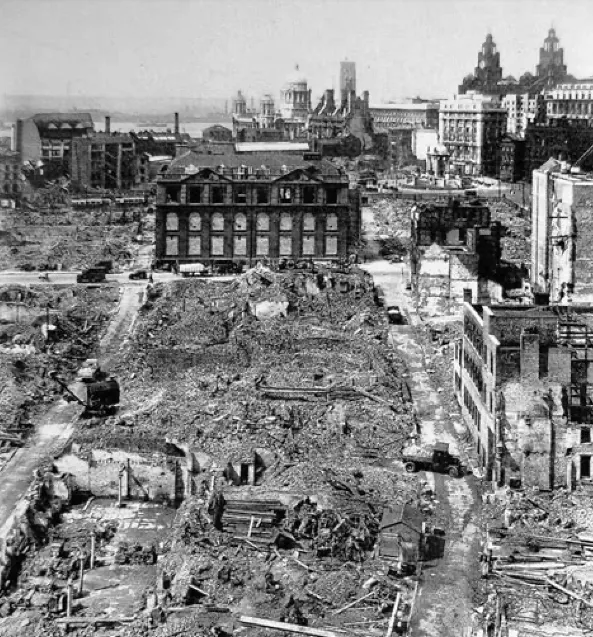
Mid-20th Century: War and Wholesale Trade
World War II’s Blitz in May 1941 devastated many Liverpool districts, especially around the docks.
The Islington area did suffer bomb damage, although not as extensively as the waterfront.

There are records of fires in nearby Gildart’s Gardens and Oakes Street during the bombing raids, but the block around Gildart, Kempston, and Constance Street seemed to have largely survived the war unscathed - being built up of mainly sturdy brick warehouses allowing trade to continuing in the post-war years.
By the 1950s and 1960s, these streets were firmly part of a wholesale market district – sometimes locally dubbed the “Rag Trade” quarter, now referred to as the Fabric District.
London Road (just a block away) was home to fabric merchants and the landmark TJ Hughes department store (opened 1925).

In the backstreets you could find many textile dealers, import warehouses, toy distributors, and clothing manufacturers.

During the 1960s, Gildart Street gained a moment of trendiness amid the fashion boom. A Liverpool entrepreneur, Bernie Stark, and his partners; one being famed John Gorman of the band “The Scaffold” capitalized on the swinging 60s fashion scene by opening The Looking Glass boutique off Dale Street.

To supply that boutique, they set up a garment workshop in the former “Mrs. Max” building on Gildart Street, leasing it from the Max family.
Sewing machines clattered on Gildart Street as they produced hip Carnaby-style clothing. However, the venture was short-lived; the business went bust in the late 1960s, leaving Mrs. Max’s warehouse empty – and her stuck paying the rates (property taxes) with no tenant. This foreshadowed a broader decline: as the 1970s approached, some traditional wholesalers began moving out and buildings fell vacant.
An evocative photograph from 1967 captures the feel of the streets at that time. In the black-and-white image, taken at the junction of Constance Street and Gildart Street, you can see typical mid-century warehouse buildings – sturdy brick structures with loading bay doors. One building bears a sign likely a merchant or manufacturer based there. Old lampposts and cobbled paving stones line Gildart Street, and a few 1960s cars are parked along the curb. The scene is industrial yet quiet – by the late 60s, the former bustle of residents had long gone, and these streets were dominated by daytime trade.

This was the era when Constance Street served mainly as a service alley for warehouses (no longer a residential row at all). Gildart Street hosted small factories and storage rooms, and Kempston Street was known for its wholesale showrooms. Longtime businesses like Try & Lilly hats continued manufacturing (a testament to the area’s textile legacy), while new ones came and went.
By the 1970s, the area’s buildings were often underused and in varying states of repair. One large warehouse at 68–76 Kempston Street (wrapping around to Constance Street) was occupied by Harris’s Toys, a wholesale toy distributor. Harris’s used the building as a storage and distribution centre, indicative of the broader wholesale market presence (indeed, the whole Islington/London Road vicinity was at that time a hub for wholesalers of toys, textiles, and domestic goods).

Harris’s Toys sub-let parts of the space to other small manufacturers: one upper floor housed G. Day & Co., a firm making belts, buckles and leather tanning work (their heavy press equipment was installed there), while another corner was sub-let to a button and stitching supplier.

An old leather press from G Day and Co., as pictured, still remains in the building today, situated in Scale on the 2nd floor (we will discuss current businesses in our future posts).
In essence, the building had become a little ecosystem of rag-trade businesses. However, this situation didn’t last. Harris’s Toys went bust in the early 1980s, leaving the warehouse in limbo and the sub-tenants paying rent directly to the bank that eventually foreclosed on the building. Many properties around were similarly “problem” buildings – either tied up in bankruptcies or simply ageing and empty as commerce patterns shifted.